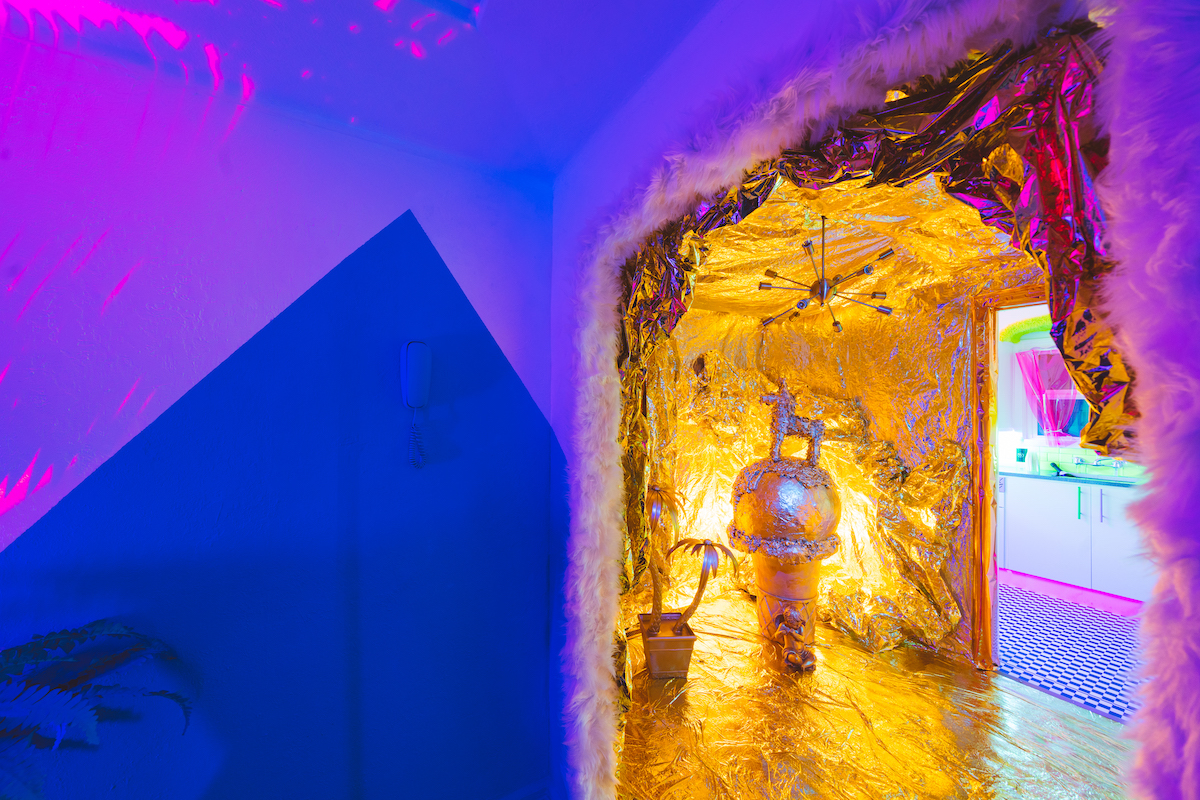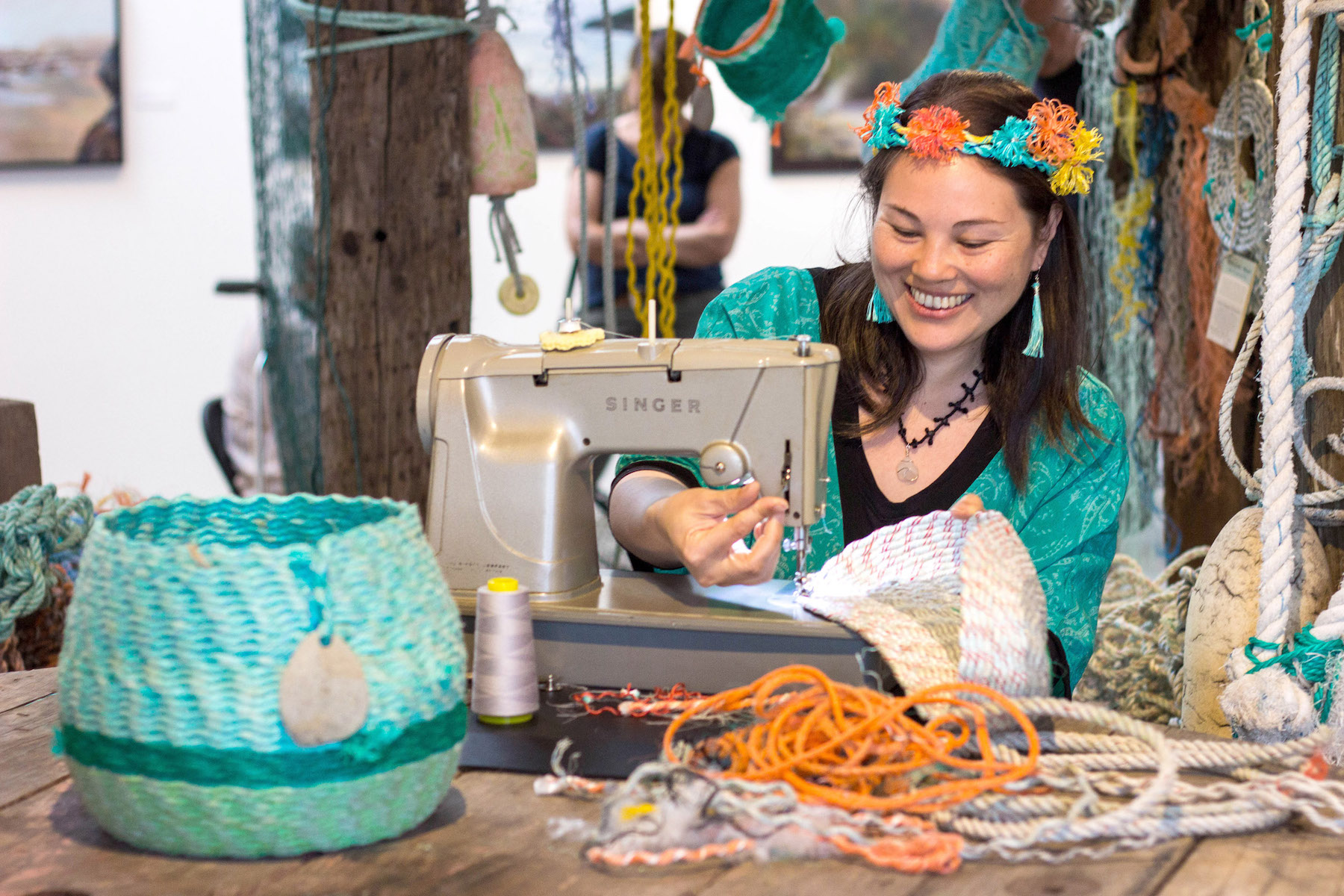After her tenants left in April 2020 during the first few months of the COVID-19 pandemic, Sol Cejas’ rental property in Vancouver, Washington, sat empty. It wouldn’t stay that way for long.
By May, a concept for an immersive art installation— the size of a house—had started to form in the Buenos Aires-born artist’s mind. By June and July, the artwork started to come together. For the next several months of the summer of 2020, Cejas worked tirelessly to design and build the installation, piece by piece.
“The entire summer, basically, my family would go places and I was like, ‘I can’t. This is what I think of when I wake up,’” Cejas said. “I’ve never had that focus [before].”
Cejas dedicated long hours to the piece, laying down paint, installing neon lights and mounting sculptures and fixtures into the ceiling. After months of work, Cejas’ vision finally took shape in the form of Haus of Luna, a spatial art installation immersive enough to walk into.
In its finished form, the Haus of Luna is unlike any house most viewers have ever seen, but it still resembles one, albeit in unfamiliar ways. The Haus has a hearth and a chimney, but nothing crackles or flickers in the fireplace besides a lone TV set tuned to static. There is a kitchen, too, but none of the appliances can prepare food, and a closer look reveals that the electric stove’s burners have been removed and replaced with record players, perhaps a nod to other forms of sustenance that can’t be eaten. In most places, the standard layouts and utilities of everyday living have been cheerfully modified, removed or altered—recognizable but jarringly out of place.
“I wanted to have usual things in unusual places,” Cejas explained, gesturing at the disparate range of familiar but oddly juxtaposed items. The arrangement and placement of the pieces evokes a feeling of the uncanny—the discovery of strange details in ordinarily familiar places and things. Unlike the uncanny encountered in psychoanalysis, Cejas’ scenes aren’t inherently unsettling—as she puts it, they are “entirely subjective.”
Cejas plays with psychology throughout the entire piece, with a surreal sense of style. Haus of Luna’s surrealist influences run deep, and Cejas displays the impact of her artistic predecessors proudly: a melting clock—a direct reference to one of Salvador Dali’s most famous works—is displayed on the mantle above the fireplace. Other influences show up in the installation such as the prolific use of abstract neon lighting—a signature medium of James Turrell, an artist that Cejas counts among her influences.
Haus of Luna dances in surrealist territory with its fixation on bringing the subconscious into the realm of conscious awareness. The installation makes a point of putting the viewer in a liminal space filled with dream colors and textures. The space becomes so thoroughly saturated with unnatural colors and juxtapositions that it is easy to forget the everyday colors and shapes of life outside.
To complete the effect, Cejas tinted windows and sliding doors throughout the installation, so that a viewer trying to catch a glimpse of the world outside the house would be met with more of the neon colours already surrounding them.
Objects, statues, mannequins and creeping vines are installed into the walls and ceiling of the house, and offer just enough clues to get a visitor’s mind guessing for explanations. Viewers are left trying to examine the work for interpretations, and the Haus leaves visitors unsure of whether the meaning they find is theirs—or Cejas’.
The Haus of Luna withholds an easy answer, but Cejas does hint at the piece’s autobiographical leanings.
“It’s kind of like a map of mind,” Cejas explained. “Obviously it’s very nostalgic.”
She pointed to a room lined with gold, gesturing at various objects connected to coming out as an artist. According to Cejas, the idea of art as a serious vocation was inconceivable to the people around her, growing up in Argentina.
“Art wasn’t a thing,” Cejas said. “It was like, yeah, that’s a great hobby. But what are you going to do? So I went to school for accounting.”
When business school failed to stamp out the closeted artist in Cejas, she finally came out to the Pacific Northwest, where she studied art and design. Since graduating, she’s worked extensively in visual imagery, but Haus of Luna represents an unprecedented evolution in her oeuvre. The piece’s unique size and scope set it apart from previous projects, but also demonstrated a physical embodiment of her experience-oriented artistic philosophy.
“We need more,” said Cejas about the future of art. “We appreciate experience now.”
A quick look at even a few of the rooms inside the Haus of Luna reveals the installation’s deliberate focus on engagement. In one room, participants are encouraged to create multicolored shadows using a heavily modified projector and objects provided for them.
In another, mirrors and lights are skillfully arranged to entice visitors to frame themselves in artfully-composed selfies. In fact, a plaque mounted on the wall encourages readers to tag Haus of Luna’s Instagram in their pictures.
In each case, the rooms and interactive artwork reflect a creative philosophy that stresses a shift towards multisensory engagement. More than just being an alternative approach to entertainment, Cejas believes that Haus of Luna’s engagement-focused style caters to a new-found preference for experience over material wealth in the culture of the United States.
“Yes, a car is neat,” Cejas said. “But it doesn’t give me the same amount of joy as going to a music festival or a concert or going out to eat. It’s an experience, and people like that.”
Unlike music festivals or concerts, the Haus of Luna frequently turns the viewer’s attention to something more intimate—themselves. In pieces like the Shadow Room, which projects the viewers’ silhouettes in cascading neon colors, Cejas playfully suggests that her viewers confront their shadows—not as something to be repressed, but as an experience to be playfully engaged with.
“We fear our shadows,” Cejas explained. “And [the Shadow Room] is like, shadows are good. Explore your shadow.”
In other parts of the house, like the “Neon Room,” guests can see and interact with their reflection through the room’s reflective ceilings and walls.
“You see different parts of yourself,” Cejas said. “You see yourself in different ways.”
Ultimately, Cejas and her work embody the need to experience something new, and this theme runs throughout the Haus of Luna, in all of it’s surreal charm.
“As humans, we need interaction,” Cejas said. “We need to experience things.”
Visitors who would like to experience Cejas’ work for themselves can visit the Haus of Luna in Vancouver, WA where it is currently exhibiting.





